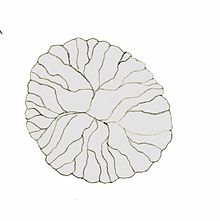This article includes a list of general
references, but it lacks sufficient corresponding
inline citations. (January 2022) |
| Rugoconites Temporal range:
Cryogenian -
Ediacaran
| |
|---|---|

| |
| Reconstruction of Rugoconites, an extinct organism | |
|
Scientific classification
| |
| Domain: | Eukaryota |
| Kingdom: | Animalia |
| Phylum: | † Trilobozoa |
| Genus: | †
Rugoconites Glaessner & Wade 1966 |
| Species | |
| Synonyms | |
| |
Rugoconites is a genus of Ediacaran biota found as fossils in the form of a circular or oval-like impression preserved in high relief, six or more centimeters in diameter. The fossils are surrounded by frills that have been interpreted ( Wade 1972) as sets of tentacles. The bifurcating radial ribs, spreading from a central dome, serve to distinguish this genus from the sponge Palaeophragmodictya, and may represent the channels of the gastrovascular system. [1] Fossils of Rugoconites have been interpreted as early sponges, [2] although this is countered by Sepkoski et al. (2002), who interpreted the organism as a free-swimming jellyfish-like cnidarian; similar to Ovatoscutum. [3] However, the fossil is consistently preserved as a neat circular form and its general morphology does not vary, therefore a benthic and perhaps slow-moving or sessile lifestyle is more likely. Ivantstov & Fedonkin (2002), suggest that Rugoconites may possess tri-radial symmetry and be a member of the Trilobozoa. [4]
Rugoconites have been reported in clusters; this may represent a social/colonial way of life, or simply accumulation by the action of currents, sea-floor processes, or possibly preservational conditions. [5]
The Rugoconites genus may contain two species: Rugoconites enigmaticus and Rugoconites tenuirugosus, the latter being less dome-shaped and having smaller and more numerous radial ridges than the former. [6] However, due to the dubious nature of R. tenuirugosus, its taxonomy is still unclear, and it has been suggested that a new genus named Wadea should be erected for ''R." tenuirugosus. [7]
In 1966, Martin Glaessner along with Mary Wade unearthed the external mould of a form which possessed a small central disc that had eleven radiating lobes from its centre that they named Lorenzinites rarus. [8] This form was also compared to the top of some Rugoconites specimens. [8] The fossil of Lorenzinites rarus was, however, reconsidered to be a Rugoconites enigmaticus specimen despite his original observations and placed it along with the genus in the synonymy of Rugoconites. [9] The genus was then forgotten about and needs further examination.
- ^ Fedonkin, M. A.; Cope, J. C. W.; Whittington, Harry Blackmore; Conway Morris, S. (1985-10-17). "Precambrian metazoans: the problems of preservation, systematics and evolution". Philosophical Transactions of the Royal Society of London. B, Biological Sciences. 311 (1148): 27–45. Bibcode: 1985RSPTB.311...27F. doi: 10.1098/rstb.1985.0136. S2CID 84598490.
- ^ Gehling, James G.; Rigby, J. Keith (March 1996). "Long expected sponges from the Neoproterozoic Ediacara fauna of South Australia". Journal of Paleontology. 70 (2): 185–195. Bibcode: 1996JPal...70..185G. doi: 10.1017/S0022336000023283. ISSN 0022-3360. S2CID 130802211.
- ^ Sepkoski, J.J.; Jablonski, D. (2002). ""A Compendium of Fossil Marine Animal Genera"". Bulletins of American Paleontology.
- ^ Ivantsov, Andrei Yu; Fedonkin, Mikhail A. (2002). "Conulariid–like fossil from the Vendian of Russia: a metazoan clade across the Proterozoic/Palaeozoic boundary". Palaeontology. 45 (6): 1219–1229. Bibcode: 2002Palgy..45.1219I. doi: 10.1111/1475-4983.00283. ISSN 1475-4983. S2CID 128620276.
- ^ Boan, Phillip C.; Evans, Scott D.; Hall, Christine M. S.; Droser, Mary L. (2023-03-13). "Spatial distributions of Tribrachidium, Rugoconites, and Obamus from the Ediacara Member (Rawnsley Quartzite), South Australia". Paleobiology: 1–20. doi: 10.1017/pab.2023.9. ISSN 0094-8373. S2CID 257521294.
- ^ "Rugoconites". Ediacaran.org.
- ^ Lipps, Jere H.; Signor, Philip W. (2013-11-21). Origin and Early Evolution of the Metazoa. Springer Science & Business Media. ISBN 978-1-4899-2427-8.
- ^ a b "The Late Precambrian fossils from Ediacara, South Australia | the Palaeontological Association".
- ^ The Dawn of Animal Life: A Biohistorical Study. CUP Archive. 20 June 1985. ISBN 9780521312165.
- "The Paleobiology database". Retrieved 2007-08-13.
- Droser, M.L. (2007). "Anchors Away: Anatomy Of An Ediacaran Sea Floor Dominated By Parvancorina". 2007 GSA Denver Annual Meeting. Archived from the original on 2011-06-08. Retrieved 2007-08-13.
- Fedonkin, M.A.; Cope, J.C.W. (1985). "Precambrian Metazoans: The Problems of Preservation, Systematics and Evolution [and Discussion]". Philosophical Transactions of the Royal Society of London. Series B, Biological Sciences. 311 (1148): 27–45. Bibcode: 1985RSPTB.311...27F. doi: 10.1098/rstb.1985.0136. JSTOR 2396968.
- Gehling, J.G.; Rigby, J.K. (1996-03-01). "Long expected sponges from the Neoproterozoic Ediacara fauna of South Australia". Journal of Paleontology. 70 (2): 185–195. Bibcode: 1996JPal...70..185G. doi: 10.1017/S0022336000023283. S2CID 130802211. Retrieved 2007-08-13.
- Ivantstov, A.Y.; Fedonkin, M.A. (2002). "Conulariid-like Fossil From The Vendian Of Russia: A Metazoan Clade Across The Proterozoic/palaeozoic Boundary". Palaeontology. 45 (6): 1219–1229. Bibcode: 2002Palgy..45.1219I. doi: 10.1111/1475-4983.00283.
- Sepkoski, J.J.; Jablonski, D.; Foote, M. (2002). "A Compendium of Fossil Marine Animal Genera". Bulletins of American Paleontology (serial monograph). 363 (1). Paleontological Research Institution: 560.
- Waggoner, B.M. (1995). "Ediacaran Lichens: A Critique". Paleobiology. 21 (3): 393–397. Bibcode: 1995Pbio...21..393W. doi: 10.1017/s0094837300013373. JSTOR 2401174. S2CID 82550765.
- http://www.yuzonakano-secretmemory.com/life3.c.html contains a low-quality image.